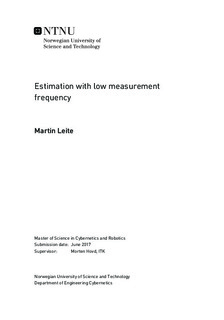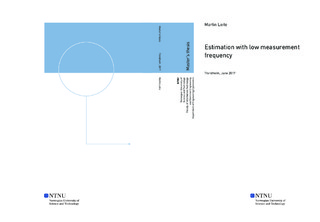| dc.description.abstract | The invention of the computer has triggered a technological revolution in many parts of
society. For the process industry, computers have led to improvement in both production
rates, safety and profits. One way this has happened is through the use of online estimators.
In the process industry, such estimators are typically used for decision support systems or
as soft sensors for advanced process control. The Kalman filter has been one of the more
popular estimators since its introduction in 1960. Since then, many versions of the Kalman
filter have been developed in order to deal with systems with different characteristics. For
nonlinear systems where all measurements are not available on every time step, the Multirate
Extended Kalman filter can typically be applied. It is not straight forward to decide
how the Kalman filter should be tuned for the best possible performance when different
measurements arrive at different rates.
This thesis has two main objectives. The first is to look at the possibility of determining
any criteria for how the noise parameters of the Multi-rate Extended Kalman filter should
be tuned to achieve the best possible estimates when the measurement frequencies vary.
The second objective is to evaluate if it is reasonable to perform all the different infrequent
measurements simultaneously or if they should be spread out, for cases where it is possible
to decide the measurement frequencies.
To be able to test these objectives, a model of the the aluminium electrolysis process
has been developed. The aluminium electrolysis process is used as an example process because
it is common to use multiple infrequent process measurements like the temperature
and height of the electrolysis bath, the metal height and the aluminium fluoride concentration
in the monitoring of aluminium electrolysis cells. Early in the thesis, an introduction
to the aluminium electrolysis process and the theory behind the Discrete, Extended and
Multi-rate Extended Kalman filters is given. This lies to foundation for the model development
and testing of the Kalman filter properties.
In order to investigate the objectives of the thesis, the developed model has been used
both as a simulated process with one set of parameters, and as a model using a slightly different
set of parameters. The difference in parameters is used to simulate modelling errors,
as it will create a process-model mismatch. The Kalman filter has then been used to correct
for this mismatch by estimating on the changed parameters. The obtained results seem to
indicate that there is no significant difference in estimator performance between using joint
measurements or shifting the time at which measurements are performed. With regard to
Kalman filter tuning for varying measurement frequencies, non of the results suggest that
the optimal tuning is significantly altered by a change in measurement frequency. | |

